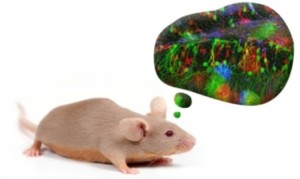for flute(=piccolo), clarinet(=bass clarinet), piano, violin, viola and cello March 2012; 7’30”
Premiere: The Chimera Ensemble, Timothy Ferguson (cond.), York Concert Series, 14th June 2013
As I was writing this piece, which unravelled from the opening gesture into something of a drama for ensemble, I discovered Brainbow mice.
“In the 1960s, scientists found that a particular jellyfish makes a protein that glows, known as green fluorescent protein. In the 1990s, using genetic engineering, researchers found that they could take the gene that makes GFP and insert it into the DNA of other cells. This makes different parts of the cell glow – and thus easier to see in a microscope – depending on where the gene is placed.
“…collaborators at Harvard University were able to genetically alter mice so their neurons produce fluorescent proteins, and each cell produces a random combination of the colors yellow, red, and cyan. These colors mix, the way the basic colors of a television screen mix to produce a range of hues. Images can be taken in living mice, and the genetic engineering does not harm them. To celebrate this, the scientists decided to appropriately name the species: Brainbow Mice.”
[Source: http://www.nextnature.net/2007/11/brainbow-mice]
While I neither set out with nor assumed any programmatic intent, the brightly coloured images showing the workings of a mouse’s brain – with scattered and distracted, reoccurring thoughts? – seemed to fit with the musical gestures I was composing and treating with such flexibility.
‘a very accessible piece of installation art… that fully exploits the instruments and their dynamic range. It was performed with humour and panache and the performers maintained the tension of the piece throughout… an example of how a simple idea can be transformed into a delightfully witty and satisfying performance.’
Brainbow mouse
for flute(=piccolo), clarinet(=bass clarinet), piano, violin, viola and cello
March 2012; 7’30”
Premiere: The Chimera Ensemble, Timothy Ferguson (cond.), York Concert Series, 14th June 2013
 “…collaborators at Harvard University were able to genetically alter mice so their neurons produce fluorescent proteins, and each cell produces a random combination of the colors yellow, red, and cyan. These colors mix, the way the basic colors of a television screen mix to produce a range of hues. Images can be taken in living mice, and the genetic engineering does not harm them. To celebrate this, the scientists decided to appropriately name the species: Brainbow Mice.”
“…collaborators at Harvard University were able to genetically alter mice so their neurons produce fluorescent proteins, and each cell produces a random combination of the colors yellow, red, and cyan. These colors mix, the way the basic colors of a television screen mix to produce a range of hues. Images can be taken in living mice, and the genetic engineering does not harm them. To celebrate this, the scientists decided to appropriately name the species: Brainbow Mice.”
As I was writing this piece, which unravelled from the opening gesture into something of a drama for ensemble, I discovered Brainbow mice.
“In the 1960s, scientists found that a particular jellyfish makes a protein that glows, known as green fluorescent protein. In the 1990s, using genetic engineering, researchers found that they could take the gene that makes GFP and insert it into the DNA of other cells. This makes different parts of the cell glow – and thus easier to see in a microscope – depending on where the gene is placed.
[Source: http://www.nextnature.net/2007/11/brainbow-mice]
While I neither set out with nor assumed any programmatic intent, the brightly coloured images showing the workings of a mouse’s brain – with scattered and distracted, reoccurring thoughts? – seemed to fit with the musical gestures I was composing and treating with such flexibility.
‘a very accessible piece of installation art… that fully exploits the instruments and their dynamic range. It was performed with humour and panache and the performers maintained the tension of the piece throughout… an example of how a simple idea can be transformed into a delightfully witty and satisfying performance.’
(Alan Gillott, One & Other York)